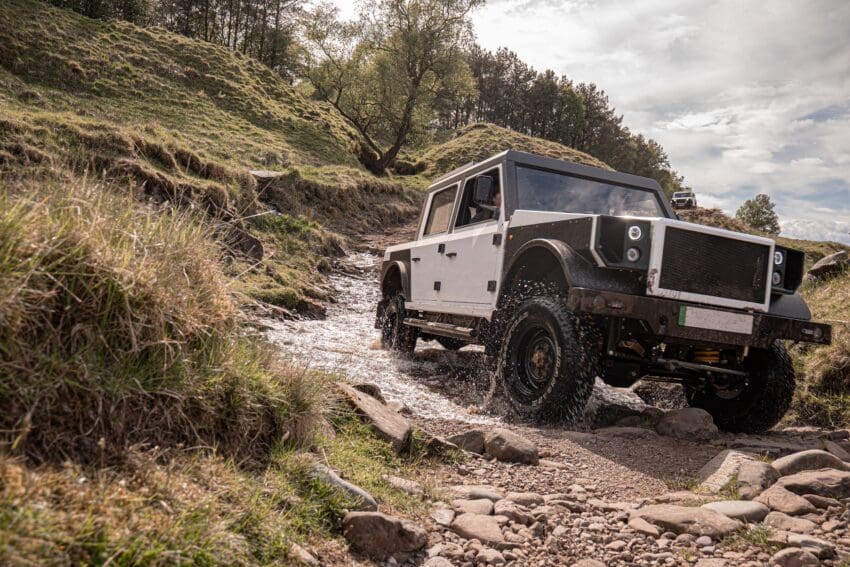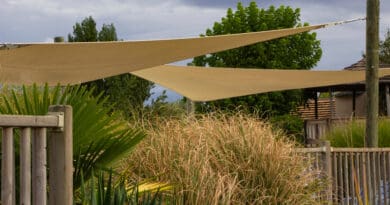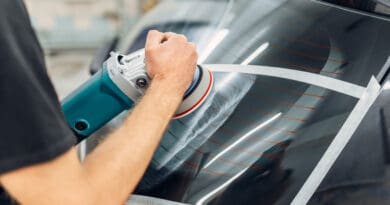
Munro EV: The Scots firm looking to scale new heights with its off-road EV
EV Powered speaks to Russell Peterson, CEO and co-founder of Scottish start-up Munro EV to learn more about the brand’s ambition to develop a truly all-terrain electric vehicle.
Like all good automotive stories, the roots of Munro EV don’t begin in some stuffy boardroom with accountants tapping away on calculators. Instead, the seed of this Scottish EV start-up can be traced back to a friendly chat over a campfire somewhere in the Highlands.
It was there that off-road enthusiasts Russell Peterson and Ross Anderson decided that what the world needed was a truly capable off-roader powered by electricity.
Having driven their share of diesel-powered 4x4s, the pair recognised the potential of an electric powertrain in coping with tough terrain where torque and fine control are more important than speed and range.
Russell explains: “I grew up on a farm, so I was always into 4x4s. As I grew up, I moved into software, but I was missing the feeling of the outdoors adventure, so I started off-roading as a hobby.
“It started out as I was driving around in diesel and petrol 4x4s and thinking ‘it would be great if this was electric’. Then my friend Ross Anderson, who’s our co-founder, and I went on this camping trip up into the Highlands and we both had this epiphany of ’this definitely needs to be a thing’.

“This was back in 2018 and most electric vehicles were like the Renault, Zoe, Nissan Leaf and quite early Teslas. So we were thinking ‘what if it had this really rugged, mechanical off-road drivetrain and could navigate really extreme terrain, but had electric drive?’.”
Spark of inspiration
The idea of a “proper” off-roader with Land Rover-like ability but a zero-emissions powertrain started out as a one-off vehicle for their own amusement but, says Russell, as they considered it more the duo realised there was a wider demand.
“It started out as a very personal thing, but then we started thinking about it further, thinking maybe this thing has legs and could work in the market.”
That shift from hobby to business idea also brought a change in focus from a leisure activity vehicle for weekend bog-bashing to a workhorse designed for some of the toughest industries on earth.

Says Russell: “When we started thinking about commercialisation, we were getting a lot of outreach from commercial groups and fleet operators who said to us, look, we’ve electrified our cars, electrified our vans, but we’re really struggling to electrify our 4×4 fleet. And that really was the birth of Munro.”
That interest, says Russell, helped focus the company’s direction and determine its core mission. This was not to be a road vehicle that could be taken off-road but something designed to spend its life away from the Tarmac in hostile working environments – whether in the frozen mines of Scandinavia or the boggy hillsides of Scotland.
Ready for anything
To that end, the Munro Series M uses a single electric motor of up to 280kW (375bhp) connected to a traditional four-wheel-drive system with a transfer box, high-low ratios and up to three locking differentials. There’s no complicated multi-motor arrangement or expensive in-wheel tech, just a tried-and-tested four-wheel-drive format with an electric motor in place of a diesel one.
Form follows function with a brutally boxy body constructed from simple-to-make and easy-to-replace panels, and with touches such as in-board lights and scratch-resistant finishes to minimise the risk of damage. That sits atop a high-riding chassis designed to cope with the roughest terrain and most challenging climbs and descents.
The utility body provides a spacious, if spartan, cab for five occupants while pick-up and chassis cab variants offer flexibility and scope for custom bodies. All three bring the benchmark 3.5-tonne towing and one-tonne carrying capacity of any self-respecting utility vehicle. Range is around 170 miles on-road or, more importantly, 16 hours of operation off-road.

Such stats are important when Munro’s target customers are forestry operators, blue-light services, mining companies and utility firms working in the most remote locations. These are the people for whom the current crop of heavily compromised electric pick-ups simply aren’t tough enough.
“We’re pretty much exclusively operating at the extremes of the market,” Russell tells EV Powered. “We’re working with mining, forestry, fire and rescue, and defence. We don’t even think about the vehicle as a car, we are treating this more like a piece of machinery.”
Customer focus
From the start, Russell says Munro’s focus has been on building the vehicle customers want and delivering the services they need.
Early on, the firm interviewed 120 fleet managers and users to understand how they use their vehicles, and early “validation” prototypes were provided to customers as part of a rolling test bed.
Feedback from those interviews and early customers has helped shape the Series M’s development and features, with a focus on keeping things simple.
“If you’re building a product for a consumer market, you can sell the customer things that they didn’t know they needed,” notes Russell. “With the commercial vehicle space, it’s the complete opposite. They know what they need, they don’t need anything more or less than that.”
So the Series M has hard-wearing touchpoints, a hose-down interior, heated seats and vehicle-to-load power. But it doesn’t have the multiple drive modes, massive touchscreen or fancy sound system of a modern SUV or pick-up.

It also, crucially, has fewer moving parts than an ICE equivalent and a simple, easy-access construction. That’s useful on a road car but on a vehicle that could be hundreds of miles from a service centre it’s a massive advantage.
Russell talks of visiting a mining site off the coast of Scotland. Every diesel pick-up at the facility had a dashboard lit up with warnings about clogged air filters, blocked DPFs and a host of other engine-related issues. Being located several hours and a ferry ride from the closest dealership meant manufacturer support was too expensive and complicated to arrange, leaving the trucks to succumb to problems that simply don’t affect an electric motor or battery.
From Scotland to the world
Munro’s name hints both at its rugged ambition and its Scottish roots – Munros are the country’s challenging mountains measuring more than 3,000 feet. And while it’s focused on serving customers worldwide, the small team at the heart of the organisation is proud of its Scottish origins.
The vehicle has been developed on off-road trails around the country, prototypes built in East Kilbride and early customer test models shipped to operators in the Highlands and Islands.

Russell says there’s a focus on using local suppliers and smaller enterprises wherever possible. Scottish firms provide everything from chassis metalwork to the seats, while components such as motors and suspension are sourced from as nearby as possible and integrated in-house.
“We try to prioritise local. So the first thing we’ll do is we’ll look at Scottish companies and UK companies, and if we can’t find anything in that region, we’ll look at Northern Europe. That is reflected in the bill of materials. You’re looking at about 80% through UK suppliers, which is pretty good, I think.”
Parts are sourced from experts in their respective fields – “There’s no need to reinvent the wheel here” – but Munro’s team also takes a very hands-on approach.
“There’s so many businesses that are founded on a great idea but can’t execute. They end up with this committee of people that have all these amazing ideas but can’t execute, can’t actually put spanner to machine,” reflects Russell.
“I think our secret was bringing people into the team from a very early stage who aren’t necessarily known names in the automotive industry, but they’re makers. They’re really good at just saying; ‘I get that. I can see how we can do that. I’m going to go in the workshop and machine that part, or weld that together’. Just going ahead and doing it.”
‘Hyperfocus is critical
That’s one attribute Russell believes will help Munro succeed where others have failed.
Recent years have seen the automotive sphere littered with EV start-ups which flounder. Look at Lunaz, Arrival, Canoo or Volta. Russell admits that it’s a tough landscape, and getting the Series M to market hasn’t been easy. But he’s confident Munro is taking a sustainable approach.
“We have a team that’s so dedicated to just doing what we set out to. Not talking about all the things we possibly could do, but looking at what we can do today to move the business forward every day,” he says.
“Hyperfocus is critical. We just keep boiling it back to ‘what will it be doing on a day-to-day basis?’ and not getting distracted by all the things we could do with the platform.”

Russell says Munro is determined to avoid the overreach which he believes tripped up some EV start-ups.
“We’re not trying to create a compromise for the whole market, and we’re also not being greedy and thinking the global market for this is enormous.
“We know what we’re good at. We’re going to build this very specialist vehicle for a very specialist market. People will need one or they won’t. And that’s fine.”
That focus on a narrow market and dedication to delivering what customers ask for – whether it’s a better turning circle or an accessories fit-out service – will be vital, especially as the hands-on hand-built approach makes way for large-scale production. After five years of relatively low-key development, the firm recently revealed it has an order bank worth £17m that it plans to deliver upon in the next 18 months.
Scaling up
Up until now, Munro vehicles have been built at the firm’s HQ in East Kilbride. However, by mid-2026 operations will have moved to a new factory on the outskirts of Glasgow.
By the end of next year, Munro aims to have built between 100 and 200 customer vehicles, ultimately ramping up to around 500 units a year, each tailored to customer’s specific needs.

Even as it progresses from the hand-built to volume manufacturing, Russell says Munro remains focused on using customer feedback to fine-tune the vehicle.
“We’ve got customer vehicles out in the real world already supported by the factory and being continuously improved and developed and we’re going to keep doing that. It’s working really well for us and the customers.
“We’re at the tailend of our development now, so next year we’ll get to the point where we can put on more of a production line. But the vehicles will still be made to order and probably each one will be a little bit different from the last one because of customer specifications.”
There’s clearly still a lot of work ahead to get to that point but if any vehicle feels built to traverse such tough terrain, it’s the Munro Series M.





